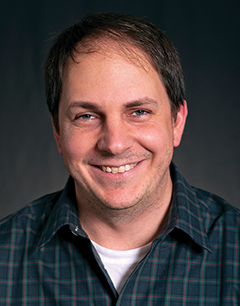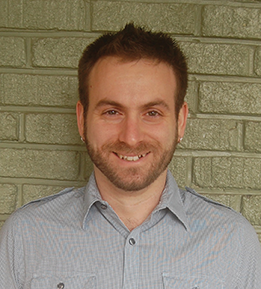Focusing on Fundamentals
You may not realize that you’re carrying around a little bit of neutron star inside. Or that this sentence won’t take long to read, but the technology that made it possible took decades of scientific discovery and creative thinking. From astrophysics to quantum materials, massive stars to atoms, the physics department engages in fundamental research that helps explain the world we live in and improve how we live in it. With awards totaling more than $6 million, Andrew Steiner and Steve Johnston provide two examples.

Andrew Steiner
Steiner, associate professor, is the principal investigator on a $3.25 million National Science Foundation grant to establish the Nuclear Physics from Multi-Messenger Mergers (NP3M) Focused Research Hub.
When the core of a massive star collapses under the weight of its own gravity, the result may be a black hole, or a much denser neutron star. The 2015 detection of gravitational waves—"ripples" in space-time set off by black hole collisions—not only won a Nobel Prize but also gave astrophysicists an additional tool to observe objects in the universe. In 2017 scientists detected a gravitational wave signal from the collision of two neutron stars.
For millennia the best information neutron stars provided to curious astronomers came from photons—quanta of light. Having additional data from gravitational waves ushers in a new era of "multi-messenger" astronomy. Coupled with advanced computational power, this approach can help scientists create ever-more sophisticated simulations to link their neutron star observations to nuclear physics and help them answer fundamental questions about matter.
"One way I like to think of it is using neutron stars as a laboratory," Steiner said. "Everything is made out of atoms and nuclei, and nuclei are dictated by how neutrons and protons interact. One way of understanding how they work is by pushing them a little in one direction or the other. We make them a little hotter, a little denser; we put them in a different environment (or) give them a little bit of a magnetic field—all of these things are kind of knobs that we turn so that we can figure out more about what’s going on. Neutron stars allow us to study matter in many different ways."
He explained that the detection of gravitational waves was a strong indicator that neutron star mergers play an important role in creating heavy nuclei, such as the iodine necessary for our thyroids to function.
"We all carry a little neutron star within us," Steiner said.
The NP3M collaboration includes another 13 senior investigators (including UT Physics Professor Raph Hix) representing universities and national laboratories across the United States, as well as collaborators from across the world. The program emphasizes training a diverse cadre of new doctoral graduates to ensure a next generation of scientists will broaden the field and carry the research forward.

Steve Johnston
Like Steiner, Johnston uses modern computational tools to pursue fundamental research, though the systems he studies are much, much smaller. His interests lie in quantum materials.
From the first transistor to supercomputers that can perform 200,000 trillion calculations per second, science and engineering have made giant strides in developing tools that make our lives safer, healthier, and easier. Advances in materials enabled this progress. For example, modern computing would not be possible without semiconductors. Similarly, future revolutions in science, engineering, and technology will be driven by advances in quantum materials.
Johnston, an associate professor, sees the origins of such enormous gains at the microscopic level. Capitalizing on UT’s multidisciplinary expertise, he won $3 million in support from the US Department of Energy Office of Science to use artificial intelligence in predicting how quantum materials behave.
Where quantum mechanics are in play, atoms and their smaller constituents can behave in ways that defy classical expectations. Electrons, for example, typically repel one another. Yet in correlated quantum materials they react so strongly with each other that their properties can become strongly coupled and entangled. Understanding the behavior of such strongly interacting systems is a grand challenge of modern science, but has merit well beyond scientific curiosity.
The surprising phenomena that emerge in quantum materials have the potential to transform billion-dollar industries ranging from consumer electronics, classical and quantum computing, medicine, and energy production, storage, and transmission. Johnston sees these novel properties as a path to revolutionize technology. Designing those materials, however, requires solving some complex problems.
"If you want to engineer quantum materials for specific purposes then you need to understand the microscopic origin of their behavior," he said.
"This is becoming particularly evident when you start coupling different materials together, and new unexpected functionality appears at the interfaces between them. As we develop new quantum materials and incorporate them into novel devices, we need to identify which factors control this functionality."
He and fellow researchers will use artificial intelligence and machine learning tools to develop computational frameworks for untangling the complexity of these systems.
"Creating these types of methods requires expertise at the interface between physics, electrical and computer engineering, computer science, and materials science," Johnston said. "UT’s ability to lead projects like this is tightly linked to institutional support of interdisciplinary initiatives like the Quantum Materials for Future Technologies cluster."
Though their labs may be as large as stars or as small as atoms, UT’s physicists build collaborations to pursue the fundamental research discoveries that drive innovation and make life, and lives, better.